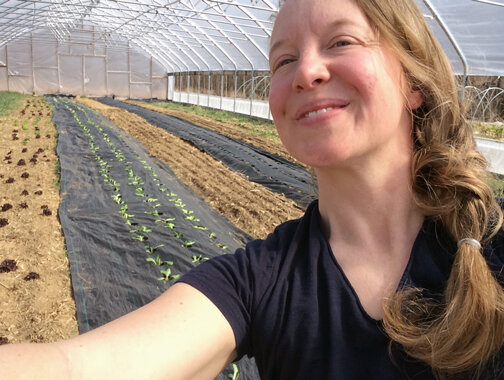While we don’t specialize in one single crop, and instead plant a rainbow every year, we do invest the most time and energy into greens. Lettuce, in particular.
On Wednesday, our first lettuce crop of the season went in the Big Tunnel. And for the first time in the farm’s history, we’re growing lettuce with the help of landscape fabric.
After working up the beds, Jay spread mushroom compost before rolling out the fabric and pinning it in place. Then, on Wednesday afternoon, I transplanted about 400 lettuces, all started from seed by Jay. This weekend, we’ll transplant another 400. This will be our second season of transplanting about 800 lettuce heads per week. We’ll continue this process through the end of October.
About 400 lettuce heads went in the Big Tunnel this week. Another 400 will go in the ground this weekend. We’ll transplant about 800 baby lettuces, every week, through late October.
While 800 per week may sound daunting, it’s just a matter of routine. Jay built the weekly lettuce seeding into his schedule, and we know that every week we must commit to snuggling all those little, green babies in the ground. After all, lettuce is one of our biggest sellers. When we attended farmer’s markets, it’s what drew people to our stands. It’s what brings people to our farm cooler. And it’s a staple of our weekly CSA shares.
Homegrown lettuce is tender and refreshing. We begin and end the season with varieties that prefer cold weather, and then switch to ones that can withstand summer swelter. In total, we grow about a dozen varieties. Jay prefers the butterheads. His favorite is Adriana, with its thick, dark green leaves. For me, it’s the silky panisse. This oakleaf is the prettiest yellow-green, like spring leaf buds, and when you hold it by the stem, it looks like a ruffled taffeta skirt.
Jason loves the butterhead lettuces, especially Adriana (shown). Photo: Johnny’s Selected Seeds
My absolute favorite lettuce is panisse, with its luxurious, silky texture.
When harvested properly (in the cool of morning or evening), fresh greens have a lengthy fridge life. (Typically, a solid two weeks, if not three.)
In the first few years of the farm, we grew loose-leaf lettuce. When I think about those days, I still shudder. We struggled to germinate the seeds, and then the rows would be fiercely overtaken by weeds. At that time, our son was a baby, then a toddler, so my life ran on his feeding, sleep, and mood schedule. Without the option of harvesting consistently in the early morning or evening, I often cut lettuce leaves during the hottest hours of the day, then had to soak them to remove the field heat. A vivid memory of that farm era is a grouchy, sweaty, fed-up toddler, leaving shade cover to march over and reach his pudgy little hands up to his equally grouchy, sweaty, fed-up mother.
In those years, I hated lettuce. I could barely look at it when I didn’t have to. Our system back then was a bad one, and we knew it was holding back the farm’s potential.
So, a few winters ago, Jay took an online lettuce course. Since then, we’ve adopted many of the same methods as the wonderful, practical, and efficient Ray Tyler, of Rose Creek Farms. Tyler is the one who showed us how effective it is to start lettuce indoors, and commit to transplanting. We’ve eliminated the germination problem, with Jay carefully tending to the seed trays in our home, and, almost as importantly, we’ve optimized our harvests.
When we dealt in loose-leaf greens, hours were wasted picking through weeds and slicing practically one piece at a time. And all that toil yielded only a few pounds of lettuce. Now, we can chop hundreds of lettuce heads in a matter of mere minutes. Every week, during the CSA, it takes roughly a half hour to chop around 200 heads for the shares. If you made a timeline of the farm, our switch from loose-leaf to head lettuce would get an understated tick mark as a notable gardening development. But a little dash doesn’t even begin to convey what this change actually meant to us, on both the personal and business levels.
~ Stella


